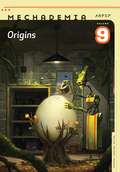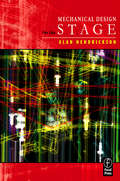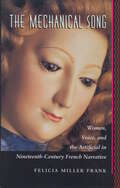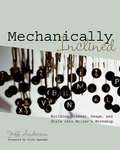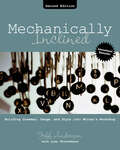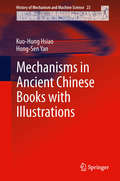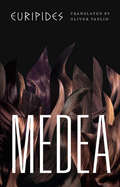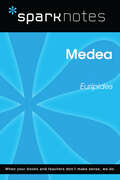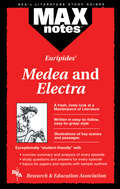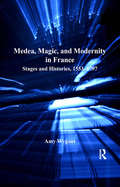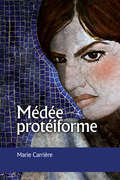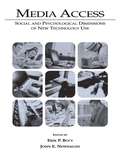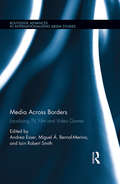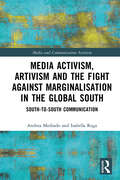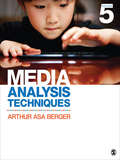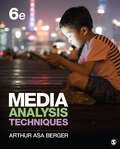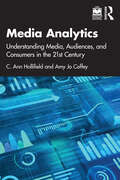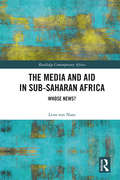- Table View
- List View
Measuring Up to the New York P-12 Common Core Learning Standards-English Language Arts, Level H
by Mastery EducationThis program helps prepare students for the rigorous expectations of the New York State Test for English Language Arts. This book is divided into three units that cover the four main categories in English Language Arts. Language - Unit 1; Writing - Unit 1; Reading Literature - Unit 2; and Reading Informational Text - Unit 3. There are many opportunities in this book to help your child practice reading.
Mechademia 3: Limits of the Human
by Frenchy LunningDramatic advances in genetics, cloning, robotics, and nanotechnology have given rise to both hopes and fears about how technology might transform humanity. As the possibility of a posthuman future becomes increasingly likely, debates about how to interpret or shape this future abound. In Japan, anime and manga artists have for decades been imagining the contours of posthumanity, creating dazzling and sometimes disturbing works of art that envision a variety of human/nonhuman hybrids: biological/mechanical, human/animal, and human/monster. Anime and manga offer a constellation of posthuman prototypes whose hybrid natures require a shift in our perception of what it means to be human.Limits of the Human—the third volume in the Mechademia series—maps the terrain of posthumanity using manga and anime as guides and signposts to understand how to think about humanity&’s new potentialities and limits. Through a wide range of texts—the folklore-inspired monsters that populate Mizuki Shigeru&’s manga; Japan&’s Gothic Lolita subculture; Tezuka Osamu&’s original cyborg hero, Atom, and his manga version of Fritz Lang&’s Metropolis (along with Ôtomo Katsuhiro&’s 2001 anime film adaptation); the robot anime, Gundam; and the notion of the uncanny in Ghost in the Shell 2: Innocence, among others—the essays in this volume reject simple human/nonhuman dichotomies and instead encourage a provocative rethinking of the definitions of humanity along entirely unexpected frontiers. Contributors: William L. Benzon, Lawrence Bird, Christopher Bolton, Steven T. Brown, Joshua Paul Dale, Michael Dylan Foster, Crispin Freeman, Marc Hairston, Paul Jackson, Thomas LaMarre, Antonia Levi, Margherita Long, Laura Miller, Hajime Nakatani, Susan Napier, Natsume Fusanosuke, Sharalyn Orbaugh, Ôtsuka Eiji, Adèle-Elise Prévost and MUSEbasement; Teri Silvio, Takayuki Tatsumi, Mark C. Taylor, Theresa Winge, Cary Wolfe, Wendy Siuyi Wong, and Yomota Inuhiko.
Mechademia 9: Origins (Mechademia #9)
by Frenchy LunningIf the source of manga and anime is physically located in Japan, the temptation for many critics and scholars is to ask what aspects of Japanese culture and history gave rise to these media. This ninth volume of Mechademia—an annual collection of critical work on anime and manga—challenges the tendency to answer the question of origins by reductively generalizing and essentializing &“Japaneseness.&” The essays brought together in Mechademia 9 lead us to understand the extent to which &“Japan&” might be seen as an idea generated by anime, manga, and other texts rather than the other way around. What is it that manga and anime produce that no other medium can precisely duplicate? Is anime its own medium or a genre of animation—or something in between? And how must we adapt existing critical modes in order to read these new kinds of texts? While the authors begin with similar questions about the roots of Japanese popular culture and media, they invoke a wide range of theoretical work in the search for answers, including feminist criticism, disability studies, poststructuralist textual criticism, postcolonialism, art history, film theory, phenomenology, and more. Richly provocative and insightful, Mechademia 9 both enacts and resists the pursuit of fixed starting points, inspiring further creative investigation of this global artistic phenomenon.Contributors: Stephen R. Anderson; Dale K. Andrews, Tohoku Gakuin U; Andrew Ballús; Jodie Beck; Christopher Bolton, Williams College; Kukhee Choo, Tulane U; Ranya Denison, U of East Anglia; Lucy Fraser; Fujimoto Yukari, Meiji U, Japan; Forrest Greenwood; Imamura Taihei; Seth Jacobowitz, Yale U; Kim Joon Yang; Thomas Lamarre, McGill U; Margherita Long, U of California, Riverside; Matsumoto Nobuyuki, Tokyo National Museum; Laura Miller, U of Missouri–St. Louis; Alexandra Roedder; Paul Roquet, Stanford U; Brian Ruh; Shun&’ya Yoshimi, U of Tokyo; Alba G. Torrents.
Mechanical Design for the Stage
by Alan HendricksonScenic effects involving rotating turntables, tracking stage wagons, and the vertical movement of curtains and painted drops have become common in both Broadway and Regional theatre productions. The machines that drive these effects range from small pneumatic cylinders pushing loads of a few pounds an inch or two, to 40 horsepower winches running multi-ton scenery at speeds 6 feet per second or more. Usually this machinery is designed by theatre technicians specifically for a particular show's effect. Compared to general industry, this design process is short, often only a few days long, it is done by one person, design teams are rare, and it is done in the absence of reference material specifically addressing the issues involved. The main goal of this book is to remedy this last situation.Mechanical Design for the Stage will be a reference for you that will:* provide the basic engineering formulas needed to predict the forces, torques, speeds, and power required by a given move* give a technician a design process to follow which will direct their work from general concepts to specific detail as a design evolves, and* show many examples of traditional stage machinery designs.The book's emphasis will be on following standard engineering design and construction practices, and developing machines that are functional, efficient to build, easily maintained, and safe to use.
The Mechanical Song: Women, Voice, and the Artificial in Nineteenth-Century French Narrative
by Felicia Miller-FrankExamining the privileged relation of women to the singing voice in nineteenth-century literary works, the author argues for an emerging identification between women and artifice in the period. Beginning with texts by Rousseau and Proust that show a link between nostalgia for the maternal voice and the writer's self, the book then turns to the psychoanalytic literature on the role of the voice in the formation of the psyche. In the process, it analyses feminist polemics on the maternal voice to show how voice and rhythm together form the matrices of the subject. The voice of the soprano occupied a special place in nineteenth-century operatic history, replacing the castrato voice as a sexless, angelic, ethereal source of pleasure for the opera-goer. The author shows how these qualities are identified with women's voices in literary texts by Sand, Balzac, du Maurier and Nerval.
Mechanically Inclined: Building Grammar, Usage, And Style Into Writer's Workshop
by Jeff AndersonMechanically Inclined is the culmination of years of experimentation that merges the best of writer's workshop elements with relevant theory about how and why skills should be taught. It connects theory about using grammar in context with practical instructional strategies, explains why kids often don't understand or apply grammar and mechanics correctly, focuses on attending to the "high payoff,” or most common errors in student writing, and shows how to carefully construct a workshop environment that can best support grammar and mechanics concepts. Jeff emphasizes four key elements in his teaching: short daily instruction in grammar and mechanics within writer's workshop; using high-quality mentor texts to teach grammar and mechanics in context; visual scaffolds, including wall charts, and visual cues that can be pasted into writer's notebooks; regular, short routines, like "express-lane edits,” that help students spot and correct errors automatically. Comprising an overview of the research-based context for grammar instruction, a series of over thirty detailed lessons, and an appendix of helpful forms and instructional tools, Mechanically Inclined is a boon to teachers regardless of their level of grammar-phobia. It shifts the negative, rule-plagued emphasis of much grammar instruction into one which celebrates the power and beauty these tools have in shaping all forms of writing.
Mechanically Inclined: Building Grammar, Usage, and Style into Writer's Workshop
by Jeff Anderson Lisa ThibodeauxSome teachers love grammar and some hate it, but nearly all struggle to find ways of making the mechanics of English meaningful to kids. As a middle school teacher, Jeff Anderson also discovered that his students were not grasping the basics, and that it was preventing them from reaching their potential as writers. Jeff readily admits, “I am not a grammarian, nor am I punctilious about anything,” so he began researching and testing the ideas of scores of grammar experts in his classroom, gradually finding successful ways of integrating grammar instruction into writer's workshop.Just in time for its 20th anniversary, this long awaited second edition of Mechanically Inclined continues to merge the best of writer's workshop elements with relevant theory about how and why skills should be taught. It connects theory about using grammar in context with practical instructional strategies, explains why kids often don't understand or apply grammar and mechanics correctly, focuses on attending to the “high payoff,” or most common errors in student writing, and shows how to carefully construct a workshop environment that can best support grammar and mechanics concepts. In this new edition, longtime colleague, Lisa Thibodeaux joins Jeff in emphasizing four key elements for grammar instruction: short daily instruction in grammar and mechanics within writer's workshop; using high-quality mentor texts to teach grammar and mechanics in context; visual scaffolds, including wall charts, and visual cues that can be pasted into writer's notebooks; regular, short routines, like “express-lane edits,” that help students spot and correct errors automatically. Comprising an overview of the research-based context for grammar instruction, a series of over forty detailed lessons, updated research, compelling new mentor texts, and an appendix of helpful forms and instructional tools, Mechanically Inclined is a boon to teachers regardless of their level of grammar-phobia. It shifts the negative, rule-plagued emphasis of much grammar instruction into one which celebrates the power and beauty these tools have in shaping all forms of writing.
Mechanisms in Ancient Chinese Books with Illustrations
by Kuo-Hung Hsiao Hong-Sen YanThis book presents a unique approach for studying mechanisms and machines with drawings that were depicted unclearly in ancient Chinese books. The historical, cultural and technical backgrounds of the mechanisms are explained, and various mechanisms described and illustrated in ancient books are introduced. By utilizing the idea for the conceptual design of modern mechanisms, all feasible designs of ancient mechanisms with uncertain members and joints that meet the technical standards of the subjects' time periods are synthesized systematically. Ancient Chinese crossbows (the original crossbow and repeating crossbows), textile mechanisms (silk-reeling mechanism, spinning mechanisms, and looms), and many other artisan's tool mechanisms are used as illustrated examples. Such an approach provides a logical method for the reconstruction designs of ancient mechanisms with uncertain structures. It also provides an innovative direction for researchers to further identify the original structures of mechanisms and machines with drawings in ancient literature. This book can be used as a textbook and/or supplemental reading material for courses related to history of ancient (Chinese) machinery and creative mechanism design for senior and graduate students.
Mechanisms of Language Acquisition: The 20th Annual Carnegie Mellon Symposium on Cognition (Carnegie Mellon Symposia on Cognition Series)
by Brian MacWhinneyFirst published in 1987. Three decades of intensive study of language development have led to an enormous accumulation of descriptive data. But there is still no over-arching theory of language development that can make orderly sense of this huge stockpile of observations. Grand structuralist theories such as those of Chomsky, Jakobson, and Piaget have kept researchers asking the right questions, but they seldom allow us to make detailed experimental predictions or to formulate detailed accounts. The papers collected in this volume attempt to address this gap between data and theory by formulating a series of mechanistic accounts of the acquisition of language.
Mechthild of Magdeburg and Her Book
by Sara S. PoorSometime around 1230, a young woman left her family and traveled to the German city of Magdeburg to devote herself to worship and religious contemplation. Rather than living in a community of holy women, she chose isolation, claiming that this life would bring her closer to God. Even in her lifetime, Mechthild of Magdeburg gained some renown for her extraordinary book of mystical revelations, The Flowing Light of the Godhead, the first such work in the German vernacular. Yet her writings dropped into obscurity after her death, many assume because of her gender.In Mechthild of Magdeburg and Her Book, Sara S. Poor seeks to explain this fate by considering Mechthild's own view of female authorship, the significance of her choice to write in the vernacular, and the continued, if submerged, presence of her writings in a variety of contexts from the thirteenth through the nineteenth century. Rather than explaining Mechthild's absence from literary canons, Poor's close examination of medieval and early modern religious literature and of contemporary scholarly writing reveals her subject's shifting importance in a number of differently defined traditions, high and low, Latin and vernacular, male- and female-centered.While gender is often a significant factor in this history, Poor demonstrates that it is rarely the only one. Her book thus corrects late twentieth-century arguments about women writers and canon reform that often rest on inadequate notions of exclusion. Mechthild of Magdeburg and Her Book offers new insights into medieval vernacular mysticism, late medieval women's roles in the production of culture, and the construction of modern literary traditions.
Medallion
by Dawn L. WatkinsBefore taking his place as king of Gadalla, Trave, a young prince, must find a sacred medallion and ward off the forces of the Dark Alliance
Medea
by Euripides translated by Oliver TaplinMedea, whose magical powers helped Jason and the Argonauts take the Golden Fleece, remains one of the strongest female characters ever to appear on stage. In the play she kills her own children. Plays for Performance Series.
Medea
by Donald. J. MastronardeThis edition presents Medea, the most famous play of the Athenian tragedian Euripides, in ancient Greek, with commentary designed for university Greek classes, from second-year Greek upward. It helps students experience a classic drama as they work through the process of careful translation and gives them an appreciation of the work's artistry and its relation to its culture and performance tradition. The introduction summarizes interpretive and cultural issues raised by the play and provides background on important aspects of Greek tragedy, including language, style, and metre.
Medea (SparkNotes Literature Guide Series)
by SparkNotesMedea (SparkNotes Literature Guide) by Euripides Making the reading experience fun! Created by Harvard students for students everywhere, SparkNotes is a new breed of study guide: smarter, better, faster. Geared to what today's students need to know, SparkNotes provides: *Chapter-by-chapter analysis *Explanations of key themes, motifs, and symbols *A review quiz and essay topicsLively and accessible, these guides are perfect for late-night studying and writing papers
Medea & Electra (MAXnotes Literature Guides)
by Tamara L. UnderinerREA's MAXnotes for Euripides' Medea & Electra MAXnotes offer a fresh look at masterpieces of literature, presented in a lively and interesting fashion. Written by literary experts who currently teach the subject, MAXnotes will enhance your understanding and enjoyment of the work. MAXnotes are designed to stimulate independent thought about the literary work by raising various issues and thought-provoking ideas and questions. MAXnotes cover the essentials of what one should know about each work, including an overall summary, character lists, an explanation and discussion of the plot, the work's historical context, illustrations to convey the mood of the work, and a biography of the author. Each chapter is individually summarized and analyzed, and has study questions and answers.
Medea, Magic, and Modernity in France: Stages and Histories, 1553–1797
by Amy WygantBringing together the previously disparate fields of historical witchcraft, reception history, poetics, and psychoanalysis, this innovative study shows how the glamour of the historical witch, a spell that she cast, was set on a course, over a span of three hundred years from the sixteenth to the eighteenth centuries, to become a generally broadcast glamour of appearance. Something that a woman does, that is, became something that she has. The antique heroine Medea, witch and barbarian, infamous poisoner, infanticide, regicide, scourge of philanderers, and indefatigable traveller, serves as the vehicle of this development. Revived on the stage of modernity by La Péruse in the sixteenth century, Corneille in the seventeenth, and the operatic composer Cherubini in the eighteenth, her stagecraft and her witchcraft combine, author Amy Wygant argues, to stun her audience into identifying with her magic and making it their own. In contrast to previous studies which have relied upon contemporary printed sources in order to gauge audience participation in and reaction to early modern theater, Wygant argues that psychoanalytic thought about the behavior of groups can be brought to bear on the question of "what happened" when the early modern witch was staged. This cross-disciplinary study reveals the surprising early modern trajectory of our contemporary obsession with magic. Medea figures the movement of culture in history, and in the mirror of the witch on the stage, a mirror both appealing and appalling, our own cultural performances are reflected. It concludes with an analysis of Diderot's claim that the historical process itself is magical, and with the moment in Revolutionary France when the slight and fragile body of the golden-throated singer, Julie-Angélique Scio, became a Medea for modernity: not a witch or a child-murderess, but, as all the press reviews insist, a woman.
Médée protéiforme
by Marie CarrièreLe mythe de l’infanticide Médée a toujours connu une fortune littéraire et la littérature féminine contemporaine ne fait pas exception. L’analyse comparée de huit textes de femmes de divers horizons tente de cerner les enjeux de cette figure irréductible pour une pensée féministe actuelle sur la maternité, le sujet et l’écriture mythique. En s’interrogeant sur la pertinence particulière de la tragédie d’Euripide aux reprises médéennes, explicites ou sous-entendues, des femmes, cette étude comparée se penche sur des textes du théâtre de Marie Cardinal, Deborah Porter, Franca Rame et Cherríe Moraga, et des romans de Monique Bosco, Christa Wolf, Bessora et Marie-Célie Agnant. À travers ses incarnations transculturelles, le mythe de Médée éclaire les affres de l’exil et de l’exclusion, ainsi que certaines visions du maternel qui préféreraient peut-être rester dans l’ombre de nos présuppositions et de nos règles sociales. Bien qu’il n’y ait pas plus monstrueux ou fou que l’acte infanticide, Médée, elle, n’est pas monstre, pas folle, mais lucide, humaine à part entière, comme la voulait Euripide, alors qu’elle s’en prend à ses enfants, à la culture défectueuse, à l’histoire des hommes. La réécriture au féminin de Médée force aussi une conception du sujet qui ne revêt pas facilement sa cohérence. Mais la poétique même de cette Médée retranscrite au féminin fait preuve de sa flexibilité, son indétermination, son pouvoir de transcender la simple répétition de son mythe, vu ici autrement et différemment.
Media Access: Social and Psychological Dimensions of New Technology Use (Routledge Communication Series)
by Erik P. Bucy John E. NewhagenIn Media Access: Social and Psychological Dimensions of New Technology Use, editors Erik P. Bucy and John E. Newhagen present the latest work, theoretical explorations, and original research findings on media access from a team of internationally renowned media and technology researchers. Chapters develop expanded definitions and conceptual understandings of access to stimulate further research, offer new perspectives on policy discussions, and facilitate media participation among those at risk of being left behind. Broadening our understanding of information technology use, this collection offers: *Novel perspectives--chapters demonstrate new methods of addressing persistent questions regarding motivation, cultural context, socioeconomic resources, technical knowledge, and psychological skills required for effectual use of information and communication technologies. *Conceptual integration--each chapter addresses a vital aspect of media access and summarizes pertinent findings, weaving together results to provide much-needed integration across communication and technology studies. *Multidisciplinary approaches--chapters represent a variety of conceptual and methodological approaches, deriving social explanations from large-scale survey data, psychological explanations from experimental data, and cultural explanations from depth interviews and ethnographic methods. *Shifting the policy and research agenda--this volume extends and redirects aspects of the digital divide debate while elaborating the "media access" approach to studying new technology use. Taken as a whole, Media Access reveals complications associated with full access to new communication technologies and proposes analytical frameworks that open new avenues of scholarly investigation and policy consideration. It is intended for scholars and graduate students in journalism, mass communication, telecommunications, media studies, information science, public policy, psychology, sociology, informatics, human-computer interaction, and other disciplines concerned with the issue of media access.
Media Across Borders: Localising TV, Film and Video Games (Routledge Advances in Internationalizing Media Studies)
by Iain Robert Smith Andrea Esser Miguel Á. Bernal-MerinoWhat happened when Sesame Street and Big Brother were adapted for African audiences? Or when video games Final Fantasy and Assassins’ Creed were localized for the Spanish market? Or when Sherlock Holmes was transformed into a talking dog for the Japanese animation Sherlock Hound? Bringing together leading international scholars working on localization in television, film and video games, Media Across Borders is a pioneering study of the myriad ways in which media content is adapted for different markets and across cultural borders. Contributors examine significant localization trends and practices such as: audiovisual translation and transcreation, dubbing and subtitling, international franchising, film remakes, TV format adaptation and video game localization. Drawing together insights from across the audiovisual sector, this volume provides a number of innovative models for interrogating the international flow of media. By paying specific attention to the diverse ways in which cultural products are adapted across markets, this collection offers important new perspectives and theoretical frameworks for studying localization processes in the audiovisual sector. For further resources, please see the Media Across Borders group website (www.mediaacrossborders.com), which hosts a ‘localization’bibliography; links to relevant companies, institutions and publications, as well as conference papers and workshop summaries.
Media Activism, Artivism and the Fight Against Marginalisation in the Global South: South-to-South Communication (Media and Communication Activism)
by Andrea Medrado Isabella RegaThis book analyses a South-to-South connection between media activists and artivists – artists who are activists – in the Global South. The authors, Andrea Medrado and Isabella Rega, emphasise the urgent need to engage in South-to-South dialogues in order to create more sustainable connections between Global South communities and as an essential step towards identifying and facing global problems, such as state repression, social inequality and climate crises. Medrado and Rega analyse the characteristics of this connection, identify its unique contributions to the study of media and social change and discuss its long-term sustainability. They do so by focusing on instances when media narratives in countries of different Global South(s) intertwine and transform each other; specifically, the exchanges between Latin America (Brazil) and Africa (Kenya). They explore how media activism and artivism can be used as tools for global movement building and to challenge colonial legacies. They also discuss how to connect people with varied skill sets in different Global South contexts, promoting South-to-South solidarity, in a cross-continental challenge to marginalisation. Crucial reading for students and scholars of media activism, social movements, global media and communication, development studies and international studies, as well as activists and social movement organisations.
Media Analysis Techniques
by Dr Berger Arthur AIn the Fifth Edition of Media Analysis Techniques, author Arthur Asa Berger provides students with a clearly written, user-friendly, and hands-on guide to media criticism. He empowers readers to make their own analyses of the media rather than just accepting the interpretations of others. The book first examines four techniques of media interpretation—semiotic theory, Marxist theory, psychoanalytic theory, and sociological theory—that Berger considers critical for creative people to acknowledge if they are to understand how their creations translate to the real world. Application chapters then link popular culture to these four theories. Written in an accessible style that demystifies complex concepts, the book also includes a comprehensive glossary, study guides, and the author’s own illustrations.
Media Analysis Techniques (Commtext Ser. #No. 10)
by Dr Berger Arthur AIn the Sixth Edition of Media Analysis Techniques, author Arthur Asa Berger once again provides students with a clearly written, user-friendly, hands-on guide to media criticism. The book empowers readers to make their own analyses of the media rather than just accept how others interpret the media. Media Analysis Techniques begins by examining four techniques of media interpretation - semiotic theory, Marxist theory, psychoanalytic theory, and sociological theory - that Berger considers critical for creative people to acknowledge if they are to understand how their creations translate to the real world. Application chapters then link popular culture to these four theories. Written in an accessible style that demystifies complex concepts, Media Analysis Techniques includes a glossary, study guides, and the author's own illustrations.
Media Analysis Techniques (Commtext Ser. #No. 10)
by Dr Berger Arthur AIn the Sixth Edition of Media Analysis Techniques, author Arthur Asa Berger once again provides students with a clearly written, user-friendly, hands-on guide to media criticism. The book empowers readers to make their own analyses of the media rather than just accept how others interpret the media. Media Analysis Techniques begins by examining four techniques of media interpretation - semiotic theory, Marxist theory, psychoanalytic theory, and sociological theory - that Berger considers critical for creative people to acknowledge if they are to understand how their creations translate to the real world. Application chapters then link popular culture to these four theories. Written in an accessible style that demystifies complex concepts, Media Analysis Techniques includes a glossary, study guides, and the author's own illustrations.
Media Analytics: Understanding Media, Audiences, and Consumers in the 21st Century
by Ann Hollifield Amy Jo CoffeyThis textbook takes a case study approach to media and audience analytics. Realizing the best way to understand analytics in the digital age is to practice it, the authors have created a collection of cases using datasets that present real and hypothetical scenarios for students to work through. Media Analytics introduces the key principles of media economics and management. It outlines how to interpret and present results, the principles of data visualization and storytelling, and the basics of research design and sampling. Although shifting technology makes measurement and analytics a dynamic space, this book takes an evergreen, conceptual approach, reminding students to focus on the principles and foundations that will remain constant. Aimed at upper-level students in the fast-growing area of media analytics in a cross-platform world, students using this text will learn how to find the stories in the data and how to present those stories in an engaging way to others. Instructor and Student Resources include an Instructor’s Manual, discussion questions, short exercises, and links to additional resources. They are available online at www.routledge.com/cw/hollifield.
The Media and Aid in Sub-Saharan Africa: Whose News? (Routledge Contemporary Africa)
by Lena von NasoNews coverage on Africa is closely connected not only with how Western audiences see the continent, but also with how a wide Western audience builds its opinion on issues that carry consequences for the public's and governments' support and policy towards development aid. The Western media reinforce a picture of a continent that drowns in chaos, is dominated by conflicts, diseases, corruption and failed democratisation. Whose interests lie behind that? How does foreign news on sub-Saharan Africa emerge, which actors are relevant in its making, and on the basis of what interests do these actors shape the coverage that is then presented as 'neutral information' to a broad international audience? Closely examining the relationship between foreign correspondents of international news media and humanitarian organisations, Lena von Naso shows how the aid and media sectors cooperate in Africa in a unique way. Based on more than 70 interviews with foreign correspondents and aid workers operating across Africa, the book argues that the changing nature of foreign news and of aid is forcing them to form a deep co-dependency that is having a serious and largely unnoticed effect on Western news coverage. This comprehensive examination of a new paradigm will interest students and scholars of media and journalism, African studies, development and humanitarian studies and the aid and media communities operating across Africa.

